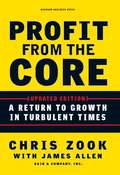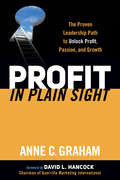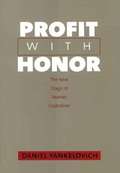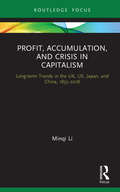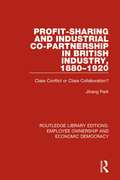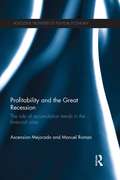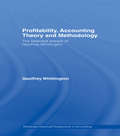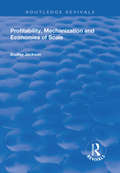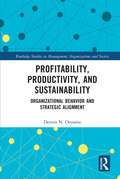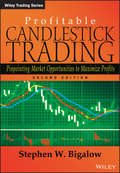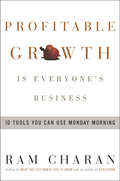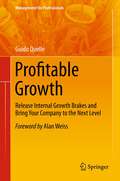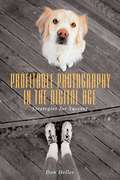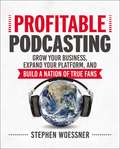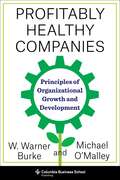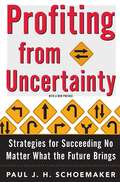- Table View
- List View
Profit from the Core
by James Allen Chris ZookWhen Profit from the Core was published in 2001, it became an international bestseller, helping hundreds of companies find their way back to profitable growth after the bursting of the Internet bubble. The 2007 global financial meltdown reaffirmed the perils of pursuing heady growth through untested strategies, as firms in industries from finance to retailing to automobiles strayed too far from their core businesses and suffered the consequences.In this updated edition of Profit from the Core, authors Chris Zook and James Allen show that a renewed focus on the core is more critical than ever as firms seek to rebuild their competitive advantage coming out of the downturn-and that a strong core will be the foundation for successful expansion as the economy recovers. Based on more than ten years of Bain & Company research and analysis and fresh examples from firms responding to the current downturn, the book outlines what today's executives and managers need to do now to revitalize their core, identify the next wave of profitable growth, and build on it successfully.Zook and Allen explain how companies can: Develop a strong, well-defined core and use it to establish a leadership position Follow the golden rule of strategy: discourage competitors from investing in your core Assess whether your core is operating at its full potential Uncover hidden assets in your core that provide the seeds for new growth Find a repeatable formula to apply core business strengths in adjacent marketsBuilding on powerful and proven ideas to meet today's formidable business challenges, Profit from the Core is the back-to-basics strategy field guide no manager should be without.
Profit from the Core
by James Allen Chris ZookWhen Profit from the Core was published in 2001, it became an international bestseller, helping hundreds of companies find their way back to profitable growth after the bursting of the Internet bubble. The 2007 global financial meltdown reaffirmed the perils of pursuing heady growth through untested strategies, as firms in industries from finance to retailing to automobiles strayed too far from their core businesses and suffered the consequences.In this updated edition of Profit from the Core, authors Chris Zook and James Allen show that a renewed focus on the core is more critical than ever as firms seek to rebuild their competitive advantage coming out of the downturn-and that a strong core will be the foundation for successful expansion as the economy recovers. Based on more than ten years of Bain & Company research and analysis and fresh examples from firms responding to the current downturn, the book outlines what today's executives and managers need to do now to revitalize their core, identify the next wave of profitable growth, and build on it successfully.Zook and Allen explain how companies can: Develop a strong, well-defined core and use it to establish a leadership position Follow the golden rule of strategy: discourage competitors from investing in your core Assess whether your core is operating at its full potential Uncover hidden assets in your core that provide the seeds for new growth Find a repeatable formula to apply core business strengths in adjacent marketsBuilding on powerful and proven ideas to meet today's formidable business challenges, Profit from the Core is the back-to-basics strategy field guide no manager should be without.
Profit in Plain Sight: The Proven Leadership Path to Unlock Profit, Passion, and Growth
by Anne C. GrahamAlmost every business leader admits that too often, they have a great year on the top line, but too little to show on the bottom line. And when they can’t or won’t take on more debt, they stay stalled, unable to fund the people, technology, equipment, facilities, acquisitions or expansion that will help their business grow and thrive. With often-overlooked solutions to the five core challenges to building a strong bottom line to fund growth, "Profit in Plain Sight" resolves that dilemma.This book will resonate with every business leader at any level who is tired of saying or hearing “We don’t have the budget for that” and wants to grow their bottom line and their business by selling more products and services, to more of the right customers, at higher prices, and lower costs. . . in less time than they’re spending on email.The 55 Profit Accelerators contained in "Profit in Plain Sight" were synthesized from over 30 years of business experience, often in tough turnaround situations. They’re proven, they’re classic, they work, they’re never taught in business schools, and they have nothing to do with conventional cost-cutting or accounting techniques. Instead, they deliver take-it-to-the-bank results.
Profit over Privacy: How Surveillance Advertising Conquered the Internet
by Matthew CrainA deep dive into the political roots of advertising on the internet The contemporary internet&’s de facto business model is one of surveillance. Browser cookies follow us around the web, Amazon targets us with eerily prescient ads, Facebook and Google read our messages and analyze our patterns, and apps record our every move. In Profit over Privacy, Matthew Crain gives internet surveillance a much-needed origin story by chronicling the development of its most important historical catalyst: web advertising.The first institutional and political history of internet advertising, Profit over Privacy uses the 1990s as its backdrop to show how the massive data-collection infrastructure that undergirds the internet today is the result of twenty-five years of technical and political economic engineering. Crain considers the social causes and consequences of the internet&’s rapid embrace of consumer monitoring, detailing how advertisers and marketers adapted to the existential threat of the internet and marshaled venture capital to develop the now-ubiquitous business model called &“surveillance advertising.&” He draws on a range of primary resources from government, industry, and the press and highlights the political roots of internet advertising to underscore the necessity of political solutions to reign in unaccountable commercial surveillance.The dominant business model on the internet, surveillance advertising is the result of political choices—not the inevitable march of technology. Unlike many other countries, the United States has no internet privacy law. A fascinating prehistory of internet advertising giants like Google and Facebook, Profit over Privacy argues that the internet did not have to turn out this way and that it can be remade into something better.
Profit with Honor: The New Stage of Market Capitalism
by Daniel YankelovichThis wise and optimistic book examines the rampant scandals that plague American corporations today and shows how companies can reverse the resulting climate of mistrust. By seizing the opportunity to address some of the nation's--and the world's--most serious problems, business can strengthen its reputation for integrity and service and advance to a new stage of ethical legitimacy. Daniel Yankelovich, a social scientist and an experienced member of the corporate boardroom, describes the toxic convergence of cultural and business trends that has led inexorably to corporate scandals. Yet he offers reassurance that opportunity exists for positive change. Creative business leaders can advance market capitalism to its next stage of evolution, building upon business norms that simultaneously emphasize the legitimacy of profit making and the importance of the care that companies give to employees, customers, and the larger society. The book asserts that American culture has abandoned its old tradition of enlightened self-interest, of "doing well by doing good. " A narrow legalism has taken over ("I didn't break the law; therefore I didn't do anything wrong"). Yankelovich argues that attempts to deal with such flawed ethical norms by means of more laws and regulations cannot succeed. He offers a series of case histories to show how and why stewardship ethics can strengthen individuals, corporations, the nation, and the world economy.
Profit, Accumulation, and Crisis in Capitalism: Long-term Trends in the UK, US, Japan, and China, 1855–2018 (Routledge Frontiers of Political Economy)
by Minqi LiKarl Marx hypothesized that there is a long-term tendency for the profit rate to fall in capitalist economies. Immanuel Wallerstein hypothesized that capitalist development tends to drive up labor cost, material cost, and taxation cost. This book evaluates Marx’s and Wallerstein’s hypotheses by studying the long-term movement of the profit rate and contributing factors in major capitalist economies. During the twentieth century, leading capitalist economies largely succeeded in stabilizing the profit rate. However, the current decline of the profit rate in China may precipitate the global capitalist economy into a new major crisis. As economic growth slows down in all major capitalist economies, Marx’s original hypothesis may be verified by the global economic events in the twenty-first century.
Profit-sharing and Industrial Co-partnership in British Industry, 1880-1920: Class Conflict or Class Collaboration? (Routledge Library Editions: Employee Ownership and Economic Democracy #6)
by Jihang ParkIn this title, first published in 1987, the author discusses the economic and industrial circumstances in Britain under which profit-sharing and co-partnership came into being. He explores the merits and drawbacks of the system as both advocates and opponents saw them, the motivations of employers in introducing profit-sharing schemes, and the implementing of such notable schemes as that of Lever Brothers, a multinational corporation based in Britain. The author also assesses the role of profit-sharing and co-partnership in the development of modern management practices and industrial relations.
ProfitLogic
by Michael J. Roberts Richard G. Hamermesh Taz PirmohamedDescribes an "application software" company that has been through several evolutions--from consulting firm to applications service provider (ASP). The firm has received significant venture funding to pursue the ASP model but this has not worked, at least at the time the case ends. The company faces a choice: continuing with its current ASP business model, increasing its burn rate to convert to a licensed software model, or decreasing its burn rate to offer a more custom version of the ASP product.
Profitability Drivers in Professional Service Firms
by Ashish NandaThis csae presents a simple model of the drivers of profitability in a professional service partnership and conducts an empirical exploration of the determinants of profitability among AmLaw 100 firms over the period 1994 to 1999.
Profitability Ratios - The Higher the Better (Mostly): The Five You Need to Know
by Karen Berman Joe KnightProfitability ratios help you evaluate your company's ability to generate profits. While there are dozens of them, there are only five that entrepreneurs need to understand and use: gross profit margin percentage, operating profit margin percentage, net profit margin percentage, return on assets, and return on equity. This chapter is excerpted from "Financial Intelligence for Entrepreneurs: What You Really Need to Know About the Numbers."
Profitability Ratios: The Higher the Better (Mostly)
by John Case Karen Berman Joe KnightProfitability ratios help you evaluate a company's ability to generate profits. This chapter looks at five key profitability ratios that every manager should understand in order to master financial statement analysis.
Profitability and the Great Recession: The Role of Accumulation Trends in the Financial Crisis (Routledge Frontiers of Political Economy #177)
by Manuel Roman Ascension MejoradoFrom the mid-1980s, investors in the US increasingly directed capital towards the financial sector at the expense of non-financial sectors, lured by the perception of higher profits. This flow of capital inflated asset prices, creating the stock market and housing bubbles which burst when the imbalance between stagnant incomes and rising debts triggered the banking meltdown. Profitability and the Great Recession analyses these trends in profitability and capital accumulation, which the authors identify as the root cause of the financial crisis, in the context of the US and other major OECD countries. Drawing on insights from Adam Smith, David Ricardo, John Stuart Mill and Karl Marx, the authors interpret the relationship between capital accumulation and profitability trends through the conceptual lens of classical political economy. The book provides extensive empirical evidence of declining rates of US non-financial corporate accumulations from the mid-1960s and profitability trends in that sector falling from post-war highs. In contrast to this, it is shown that there was a vigorous rise of profitability in the financial sector from a 1982 trough to the early part of the twenty-first century, which led to the bloating of that sector. The authors conclude that the long-term falling accumulation trend in the non-financial corporate sector, highlighted by the bankruptcy of major automobile corporations, stands out as the underlying force that transformed the financial crisis into a fully-fledged Great Recession. This book will be of interest to students and researchers in the areas of economics, political economy, business and finance.
Profitability, Accounting Theory and Methodology: The Selected Essays of Geoffrey Whittington (Routledge Historical Perspectives in Accounting)
by Geoffrey WhittingtonAn important scholar in the history of accounting, Geoffrey Whittington's numerous articles cover a broad spectrum of the field and are both sharply insightful and extremely significant. He has made important contributions to the topics of inflation accounting, accounting theory and methodology and standard-setting, and he has conducted a number of valuable empirical studies. This remarkable collection pulls together essays and articles and encompasses his work on empirical studies based on company accounts, specification of empirical models, price change accounting, taxation and regulation, and regulation of accounting and auditing. Accompanied by a new introduction and conclusion, this significant volume will be extremely useful for historians of accounting as well as accountancy practitioners and researchers.
Profitability, Mechanization and Economies of Scale (Routledge Revivals)
by Dudley JacksonFirst published in 1998, this book introduces a new concept of profitability, called the 'efficiency rate of profit', which is defined as the ratio between the unit net margin and the unit capital requirement and shows how the efficiency rate of profit may be used in the assessment of mechanization and economies of scale. The book also shows how the efficiency rate of profit relates to the financial opportunity cost of investment, thus resolving the long-standing controversy over 'interest as a cost'. Using real-world plant-level data, the book explains fully the process of mechanization, how increasing returns to scale works at the plant level through power rule relating plant or equipment cost to capacity and how and why it is more cost effective to combine mechanization with expanding the scale of production in one combined 'package' of efficiency improvement.
Profitability, Productivity, and Sustainability: Organizational Behavior and Strategic Alignment (Routledge Studies in Management, Organizations and Society)
by Dennis N. OnyamaThis book presents an in-depth study of how the drive to optimize organizational performance can be significantly improved by investigating the causal relationships between profitability, productivity, and sustainability (PPS) through an assessment of a triple combined therapy that studies the interplay between Organizational DNA, Strategic Alignments for Value, and their implications for Sustainability. Through this approach, this volume seeks to answer critical mind-searching questions and provide useful guides as to how some firms are able to sustainably create higher value or wealth, especially through corporate entrepreneurship, or via the creation of new business models than others. In tackling the three elements of profitability, productivity, and sustainability, this book also provides greater insight through an in-depth study of the pervasively unresolved and disturbing issues surrounding the prospects of increasing the chances of success for entrepreneurial start-off ventures, making it of value to researchers, academics, and students in the fields of organizational studies, strategy, and sustainability.
Profitable Art of Service Recovery
by James L. Heskett W. Earl Sasser Jr. Christopher W.L. HartService companies often cannot prevent mistakes, but they can learn to recover from them and thereby retain an unhappy customer. Recovery begins by identifying the problem, then acting quickly to correct it. Most important, service companies should give front-line employees the authority and responsibility to do what is necessary to correct a service mistake, even if it means deviating from the rules.
Profitable Candlestick Trading: Pinpointing Market Opportunities to Maximize Profits (Wiley Trading #500)
by Stephen W. BigalowThe updated edition to one of the most popular books on technical analysis Japanese candlestick charting and analysis is one of the most profitable yet underutilized ways to trade the market. Signals created by this unique method of technical analysis-represented in the form of graphic "candlestick" formations-identify the immediate direction and effects of investor sentiment through price movements, allowing traders to profit by spotting trend reversals before other investors. This updated version of Profitable Candlestick Trading: Pinpointing Market Opportunities to Maximize Profits makes learning the method fast and easy by introducing specific patterns, as well as the psychology behind them. The book Details the most valuable aspect of technical analysis-reversal patterns-as well as reversal signals, including the Doji, the Hammer, the Hanging Man, Engulfing Patterns, and Dark Cloud Cover Explains continuation patterns and explores how they can help with the decision-making process during various trading periods Reveals how to find trading situations that have the maximum potential for profitability, the highest probability of success, and the least amount of risk Learn how to quickly search, view, and profit with candlestick formations with Profitable Candlestick Trading.
Profitable Growth Is Everyone's Business: 9 Tools You Can Use Monday Morning
by Ram CharanThe coauthor of the international bestsellerExecutionhas created the how-to guide for solving today’s toughest business challenge: creating profitable growth that is organic, differentiated, and sustainable. For many, growth is about “home runs”—the big bold idea, the next new thing, the product that will revolutionize the marketplace. While obviously attractive and lucrative, home runs don’t happen every day and frequently come in cycles. Products like Kevlar, Teflon, and the Dell business model for selling personal computers may be once-in-a-decade phenomena. A surer and more consistent path to profitable revenue growth is through “singles and doubles”—small day-to-day wins and adaptation to changes in the marketplace that build the foundation for substantially increasing revenues. The impact of singles and doubles can be huge. They are not only the basis for sustained revenue growth but, in fact, the foundation for home runs. Singles and doubles provide the discipline of execution, an absolute necessity for successfully bringing a breakthrough technology to market or implementing a new business model. Inherent in this way of thinking is the revolutionary idea that growth is everyone’s business—not solely the concern of the sales force or top management. Just as everyone participates in cost reduction, so must everyone be engaged in the growth agenda of the business. Every contact of each employee with a customer is an opportunity for revenue growth. That includes everyone from the people working in a company’s call center handling customer inquiries and complaints to the CEO. In this trailblazing book, Ram Charan provides the building blocks and tools that can put a business on the path to sustained, profitable growth. For more than twenty-five years, Ram Charan has been working day in and day out with companies around the world. The ideas he has developed for solving the profitable revenue growth dilemma facing many businesses are based on personally seeing what works in real time. These are ideas that have been tested across industries and that deliver results, and they can be put to use starting Monday morning.
Profitable Growth: Release Internal Growth Brakes and Bring Your Company to the Next Level
by Alan Weiss Guido QuelleAlmost every company wants to grow - at least officially. Shareholders are demanding further growth and no management team would deny that the growth of their company is one of the top issues they are working on every single day. However, there are barriers to growth, and these are not only external barriers. Most often it is not the economy, not the market and not the customer who just "hasn't got it." The main barriers can be discovered inside every company, because growth always comes from within. If the organization is not ready to grow, initiatives to increase market share, to enter new markets, and/or to increase profitability are destined to fail. This book systematically addresses the main internal barriers to growth and provides practical guidance not only for discovering these barriers, but to systematically overcoming them.
Profitable Photography in Digital Age: Strategies for Success
by Dan HellerThis groundbreaking resource demonstrates how to use digital imaging and the Internet as the cornerstone of a successful photography business. Topics covered include setting business goals, marketing, setting prices, selling prints, running a Web-based photography business, working with stock agencies, legally protecting images, and more. Both serious amateurs considering a start-up and established businesses looking for fresh approaches need this timely, relevant book.Allworth Press, an imprint of Skyhorse Publishing, publishes a broad range of books on the visual and performing arts, with emphasis on the business of art. Our titles cover subjects such as graphic design, theater, branding, fine art, photography, interior design, writing, acting, film, how to start careers, business and legal forms, business practices, and more. While we don't aspire to publish a New York Times bestseller or a national bestseller, we are deeply committed to quality books that help creative professionals succeed and thrive. We often publish in areas overlooked by other publishers and welcome the author whose expertise can help our audience of readers.
Profitable Podcasting: Grow Your Business, Expand Your Platform, and Build a Nation of True Fans
by Stephen WoessnerDid you know there's a much better tool for spreading influence and generating revenue--one with far less competition? Podcasting offers rich opportunities, especially if you get in early and do it right.Author and CEO Stephen Woessner wants to share with you the secrets he learned in podcasting while building a $2 million venture from scratch. Profitable Podcasting lays out the precise formula Woessner has learned from experience to be necessary for creating, launching, marketing, and monetizing podcasts in any industry.Packed with priceless production help, software recommendations, web and social strategies, schedules, checklists, and examples, this indispensable guide explains exactly how to:Choose the ideal format for the type of show you are producingGet the best guestsCreate intriguing interview questionsRecord and edit like a proMaximize buzz for the launchSecure generous sponsorshipAchieve top rankings fastDon&’t let the tech side of this incredible marketing and sales outlet scare you away from the lucrative awards that await you once you conquer the short learning curve. With Profitable Podcasting navigating you through every step, you will reach the payoff quickly and painlessly.
Profitable Wedding Photography
by Elizabeth Etienne Colin CowieNow aspiring wedding photographers have a comprehensive guide to building a profitable wedding business! Drawing from her twenty-three years of experience in the wedding photography industry, author Elizabeth Etienne helps readers reduce the growing pains both in shooting a wedding and in dealing with wedding clients. Unique features include prep sheets such as: couple's questionnaire, shot list, photo timeline, helpful hints, contract, and package rate sheet. With an introduction written by celebrity wedding planner Colin Cowie, this indispensable book will teach you how to: - Create a great product - Offer dynamic customer service - Price your product and service appropriately - Package your product uniquely - Market your product effectively. Anyone looking for practical advice on how to start and grow a wedding business will need this one-stop resource from one of the most sought after wedding photographers in the world.
Profitably Healthy Companies: Principles of Organizational Growth and Development
by Michael O'Malley Warner BurkeEvery company faces challenges, but some are able to achieve long-term vitality while others flame out. What distinguishes a healthy, high-performing organization? Which ingredients, decisions, and values result in a business that is built for the long haul?Profitably Healthy Companies lays out ten essential principles of organizational development for sustained success. Bringing together practical and academic expertise, W. Warner Burke and Michael O’Malley detail proven methods for every organization at each level. They demonstrate why a focus on employee and community well-being is more likely to ensure lasting profitability than a single-minded focus on the bottom line. Burke and O’Malley explain the keys to company resilience, examining safeguards against decline and disaster as well as tools for generative renewal and growth. They show how organizational culture encourages optimal performance, flexible and adaptive corporate strategy, and employee motivation and commitment. The book emphasizes up-to-the-moment issues, such as how to center diversity and inclusion and the promise and pitfalls of remote work.Burke and O’Malley base their recommendations on research in organizational psychology as well as their own extensive consultative experience, providing a rich array of case studies and examples. Profitably Healthy Companies is a clear and authoritative guide for practitioners, leaders, and decision makers, synthesizing an all-inclusive treatment of organizational life with a comprehensive checklist of what organizations must do in order to thrive.
Profiting From Uncertainty
by Paul SchoemakerWhat manager is not anxious about the future? We live in a white-knuckled age of rapid technological change and global instability. But uncertainty is not the enemy, says management expert Paul J. H. Schoemaker. It is where the greatest opportunities are. To unlock these opportunities, however, requires a very different approach to strategy and implementation. In this pioneering book, Dr. Schoemaker presents a systematic approach that combines concepts such as scenario planning, options thinking, and dynamic monitoring to create novel strategies for profiting from ambiguity. Building on his experience with more than one hundred consulting projects in fields ranging from health care to manufacturing, from utilities to financial services, Schoemaker shows how major corporations throughout the world have used his pathbreaking methodology to prepare for an un-certain future and profit from it. In this first comprehensive approach to the subject, Schoemaker shows the reader (1) how to develop and analyze multiple industry scenarios, (2) craft nimble strategies with just the right amount of flexibility, (3) implement them using an options approach, and (4) make real-time adjustments through dynamic monitoring. As a leading academic thinker and practitioner, the author draws on the frontiers of decision science, organization theory, strategy, and cognitive psychology to integrate the most practical contributions these various fields have made to navigating uncertainty. One need only follow the news to see the risks of being unprepared for change. And yet the rewards for actively pursuing new opportunities are greater than ever. More than any other capability, skill in seizing initiatives in shifting, unpredictable circumstances is the key to success. Profiting from Uncertainty provides a road map to do just that.
Profiting From Uncertainty: Strategies for Succeeding No Matter What the Future Brings
by Paul SchoemakerWhat manager is not anxious about the future? We live in a white-knuckled age of rapid technological change and global instability. But uncertainty is not the enemy, says management expert Paul J. H. Schoemaker. It is where the greatest opportunities are. To unlock these opportunities, however, requires a very different approach to strategy and implementation. In this pioneering book, Dr. Schoemaker presents a systematic approach that combines concepts such as scenario planning, options thinking, and dynamic monitoring to create novel strategies for profiting from ambiguity. Building on his experience with more than one hundred consulting projects in fields ranging from health care to manufacturing, from utilities to financial services, Schoemaker shows how major corporations throughout the world have used his pathbreaking methodology to prepare for an uncertain future and profit from it. In this first comprehensive approach to the subject, Schoemaker shows the reader (1) how to develop and analyze multiple industry scenarios, (2) craft nimble strategies with just the right amount of flexibility, (3) implement them using an options approach, and (4) make real-time adjustments through dynamic monitoring. As a leading academic thinker and practitioner, the author draws on the frontiers of decision science, organization theory, strategy, and cognitive psychology to integrate the most practical contributions these various fields have made to navigating uncertainty. More than any other capability, skill in seizing initiatives in shifting, unpredictable circumstances is the key to success. Profiting from Uncertainty provides a road map to do just that. This book was first published in 2002, well ahead of the mega turmoil that befell the world in 2008 and beyond. The methods and tools described here have been used by many companies and are even more relevant today than when originally published. You can't do without them.
